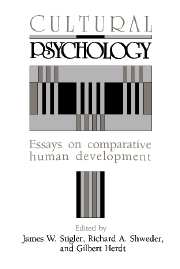Book contents
- Frontmatter
- Contents
- Preface
- Cultural psychology – what is it?
- Part I The keynote address
- Part II Cultural cognition
- Part III Cultural learning
- Part IV Cultural selves
- 10 Adolescent rituals and identity conflicts
- 11 Sambia nosebleeding rites and male proximity to women
- 12 On self characterization
- Part V Cultural conceptions of psychoanalysis
- Part VI Cultural domination and dominions
- Part VII A skeptical reflection
- List of conference participants
- Name index
- Subject index
11 - Sambia nosebleeding rites and male proximity to women
Published online by Cambridge University Press: 05 June 2012
- Frontmatter
- Contents
- Preface
- Cultural psychology – what is it?
- Part I The keynote address
- Part II Cultural cognition
- Part III Cultural learning
- Part IV Cultural selves
- 10 Adolescent rituals and identity conflicts
- 11 Sambia nosebleeding rites and male proximity to women
- 12 On self characterization
- Part V Cultural conceptions of psychoanalysis
- Part VI Cultural domination and dominions
- Part VII A skeptical reflection
- List of conference participants
- Name index
- Subject index
Summary
Since the early work of Bateson (1936) and Mead (1935), New Guinea cultures – especially in the Eastern Highlands studied by Read (1951, 1952) – have been identified with various initiatory rituals, among which none have proved as symbolically complex or theoretically controversial as those of bloodletting. In spite of considerable cross-cultural variation in the practices, researchers have not only drawn on these data, but have also reached divergent conclusions about their meaning. Furthermore, each of the proposed interpretations implied different slants on the development context of the rites that were seldom explicated, let alone demonstrated. It is remarkable, then, that after these many years of theoretical interest no ethnographer since Read (1965:127–133) had published detailed observations of these ritual behaviors until recently (cf. Lewis 1980; Poole 1982; Tuzin 1980:72–78), and none has systematically described the behavioral experience or cultural context of bloodletting in the male life cycle of a Highlands people. It is these problems – in relation to the cultural structure of nosebleeding and the ritualization of proximity to women throughout the developmental cycle – that I shall examine among the Sambia, a hunting and horticultural people of the Eastern Highlands.
New Guineasts have tended to view bloodletting rites from several analytic perspectives. Read's (1952) emphasis on the social solidarity effected by the cult context of such rites has been widely supported (Berndt 1962; Newman 1965; Strathern 1969).
- Type
- Chapter
- Information
- Cultural PsychologyEssays on Comparative Human Development, pp. 366 - 400Publisher: Cambridge University PressPrint publication year: 1990
- 11
- Cited by

